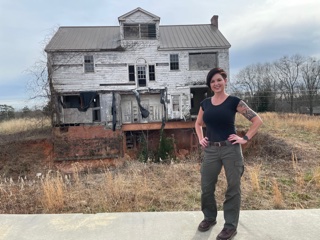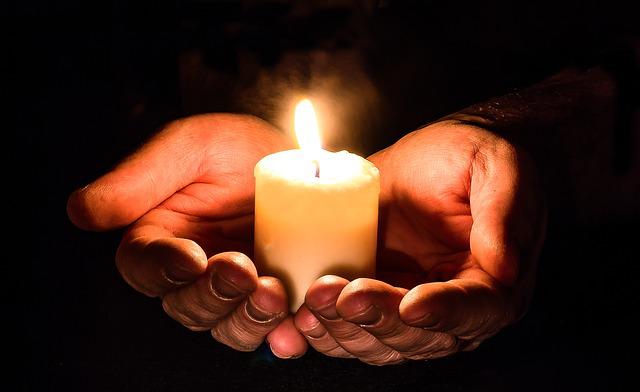The winter sun is warm on our backs when Laura Stotts pulls off Highway 64 in Rutherford County.
We’re in a rural North Carolina county on the hunt for an abandoned house and we have hit the jackpot. Following the faint grooves of a long ago driveway carved into the red clay leading up the side of the hill, we see the haughty mansion perched at the crest.
“Holy shit,” Stotts whispers when she sees the house. The structure is a grand old dame, faded with age and in a losing battle against the elements, but dignified even as she crumbles. Locals tell us later this whole field was so covered in tangled briars and scrub brush no one knew it was there until just a couple of years ago. When the land was finally cleared, the home was suddenly exposed.
I am shadowing Stotts, explorer and creator of Diary of Abandonment, a virtual journal of folklore and abandoned structures. Her Instagram has attracted more than forty thousand followers and her Facebook nearly eighty with posts shared far and wide. Her unique hobby – more of a calling she says – takes her hundreds of miles through the Carolinas, Virginia and beyond.
‘A profound connection’
Stotts, whose family history traces back to Allegheny County near the Virginia border, is a spunky dark-haired woman in her 40s who labels herself a modern day wanna-be Lady Hester Stanhope, famous British female adventurer born in 1776 who would don men’s clothes and boldly set out to explore the Egyptian desert. Instead of being the Queen of the Desert, Stotts is Queen of the Abandoned. She has also claimed the title Queen of Rust. She explores all manner of abandoned buildings, taking photographs that she shares with her thousands of social media followers. For Stotts, it is more than showcasing intriguing photos of weathered homes, it is a way to preserve the past, connect with history in an intimate way and capture its nostalgia.
“There’s a profound connection I feel to these homes and families that once lived here,” she wrote on a recent Instagram post featuring a video of a two story house tucked away in the woods.
“I can assure you it’s nothing short of a spiritual experience when walking on what feels like hallowed grounds of our ancestors. Every fiber of who I am craves a deeper understanding of the world I live in…and here, in the solitude of these homes, often shrouded in thickets and held captive by the birds singing above…it’s here that I find what I’m looking for.”
I feel the same reverence as we stand beside this old house on a hill and witness the North Carolina mountains spilling out before us in waves, the dips gently cradling the shadows while the peaks capture the sun. Pine trees march over the ridges like regiments of soldiers. It is January and we are gifted with a blue bowl of sky, a few cottony clouds wisping across it. The house was built here to bear witness to this view. At one point, it appears there were some restoration efforts. Two steel beams shore up the front and more steel beams, nearly matching the rusty soil around it, underscore the foundation at the back. Most of the windows are boarded up, while the glass in others is smashed.
Hurricane on the Gulf Coast
On the drive to the house, which she has pinned on Google maps, Stotts shares some of her backstory.
Her passion for the abandoned began with a tornado when she was 8-years-old.
She said growing up, her father worked on a crew that constructed malls around the nation and although she was born in North Carolina, the family ended up in an apartment complex in Beaumont, Texas near the Gulf coast.
“Hurricane Bonnie came through. I think it was 1986, and when hurricane Bonnie hit the coast it spawned 11 tornadoes,” she said. “Well, one of the tornadoes came right down our street. There were six of us kids and my mom. My mom is such an adventurous woman. My dad is at work, we only have one car so my mom and six kids are stuck at home. We couldn’t leave. There’s just torrential rain storms from the hurricane, sky is black, it’s this big dramatic thing going on.”
She said the apartment complex consisted of 10 buildings, each one three stories tall. She and her siblings peered out the sliding glass door as the violent storm unleashed chaos around them.
“We can literally see the roofs popping off of buildings,” she said, “It was that bad of a storm. Hoods are being ripped off of cars and flipping across parking lots. Our neighborhood was being destroyed.”
“Mom, being the trooper that she is, is like, ‘guys, isn’t this exciting. Lets just watch this.’”
When the power went out, Stott’s mother brought out chocolate popsicles from the freezer and like a Broadway show, they sat and ate them while the storm raged.
The building withstood the winds but the complex was condemned as a result of the damage inflicted.
“We were on the bottom level, our apartment did not get destroyed, and we were able to stay there a little bit longer but immediately everybody else moved out. We were poor, we didn’t have anywhere to go, and so we stayed longer probably than we should have,” Stotts said.
Overnight, the building went from a vibrant community bustling with adults and children to a ghost town.
“So for fun and out of boredom my sister and I, she was all but the same age I am, we would go explore the abandoned complex and you could hear like water dripping in the buildings from holes in the roof and the carpet is all soggy and we’d crawl through the windows. People left in a hurry and left a ton of stuff behind. There was something about that that stuck to me. Like where did all the people go?”
The seed for future explorations had been planted.
A keeper of history
Since she first began documenting her adventures several years ago, Stotts said she has visited around 200 old farm houses, a hospital, and a boys reform school.
At this particular house we find ourselves at today, we first circle around it, a technique Stott’s has adopted to alert any potential squatters or wild animals, and then make our way to the front. A broken window near the porch allows entrance and we step on a wobbly stack of wood to get from the porch to inside the house.
Stotts’ normal procedure is to track down an owner by stopping at a neighbor’s house, but there are no other residences nearby so we decide it is better to ask for forgiveness than permission.
Once inside, the house I feel the ghosts of the past swirling around us.
“Look at the fabric on that shade right there. Isn’t that gorgeous?” she points out the tattered valances draped from the top of each window, the rich maroon brocade print still visible. With phone in hand, she photographs details like these, capturing old glass door knobs, or hair curlers abandoned on a bathroom counter, posting them to Instagram and Facebook. She said she has discovered people gravitate towards the past and the memories they invoke. It reminds people of afternoons or hot summers spent with grandparents, now long gone. Beyond the allure of the abandoned, Stotts’ true passion is telling stories. Even more than an explorer, she is a keeper of history.
Inside, glass crunches underfoot and dust motes dance in beams of light coming through the cracks in the boarded up windows. Pieces of the massive columns that once graced the front porch are discarded on the floor. There is a fireplace with an intact mantel in the living room. The back wall has been knocked out, allowing for an unobstructed view of the mountains as if it were a life-size painting.
We are respectful and cautious as we carefully wind our way up the old staircase, the grand banister torn down by vandals, to the second floor.
Although Stotts said she isn’t particularly skilled at guessing the age of a house, she estimates this one is from the 1930s, relatively young compared to some, which have histories of housing civil war soldiers or the cabins with log walls still bearing the marks of the axes that shaped them.
Still, as we revertantly tiptoe through the rooms, I sense the weight of its history infused like a perfume in the air. I can feel the accumulation of hundreds of family dinners prepared in the kitchen, the decorations that surely adorned the mantel at Christmas, the footsteps of children and adults still echoing on the floor as well as the slow passage of all the daily mundane moments that have spun out between these walls.
Remaining are more tangible clues of these ghost people.
“I like to see all the little treasures people leave behind,” she said.
Hair curlers are expectantly waiting on the bathroom counter and pairs of women’s shoes, cobwebs spun inside the heels, are scattered in the attic. Everywhere there are books, newspapers and magazines. Winston Churchill grins from the cover of a 1960s National Geographic, flashing a V for Victory.
We leave everything as we find it.
“It’s fun to play detective, what they did. How long since they’ve lived here,” Stotts said. Typically the dates of magazines provide clues of when a home was last inhabited.
After we have both wandered the rooms from top to bottom of the house, we precariously climb back out the broken window.
‘He was kind of the catalyst’
Stotts said these days, there are many different abandoned house explorers but she has added her own twist.
“Most people will go in and trespass, sneaking out, taking pictures and posting it,” she said. “I would prefer to find the owner because I love the old people I meet and I totally fall in love with them. I get really close to them.”
An elderly man in his 90s became the catalyst who inspired her adventures. Stotts said she met him when she first began photographing old houses and was seeking permission to explore a particular old homestead.
He invited her and her husband in and told them they could only stay a minute. The visit lasted hours.
“He told us the most beautiful story of how he met his wife, who had been deceased for 20 years or something. Never had any kids,” she said. “Turns out he was a local star where he lived, a little music star. He talked about God and how grateful he was for his life. When we left, he let us go into the house and take pictures of it.”
He showed them photos of what the home used to look like in its heyday. The words touched her heart and not long after, she heard he had died of cancer. She was the last person to hear his life’s tale.
“He was kind of the catalyst, like holy crap. I need to do this again. I need to find out more stories because I was the last person he told a story to,” she said. “I have met the most amazing elderly people that tell me these stories.”
Stotts said she uses Google maps to find potential gems, pinning the images of houses that look promising. Some of the houses seem to find her. She’ll be driving along a country road and the weathered boards of an abandoned building, not yet engulfed by kudzu and bushes, will catch her eye. She’ll also use the historical registry website and will pick out places on the registry that are clearly abandoned.
“Sometimes they’re duds when I get there, but often they’re really good abandoned houses,” she said.
Her social media pages are devoted to the consecration and remembrance of these people and places, capturing the ghosts of the past and bringing to life historical places. She also has a knack for bringing the more ordinary and obscure into focus. Stotts said her dedicated fans are more than just followers.
She calls them “kindred spirits.”
“We’re like-minded in heart and spirit; we share a love of our ancestors, a longing for simpler times, and a homesickness we can’t explain,” she wrote on Facebook.
Recently, she has featured the ruins of an ancient church in the lowcountry of South Carolina; an old stone house built in 1785 by a Colonel in the Revolutionary War; and a scattering of anonymous homesteads sprouting up in the woods and weeds, boards weathered to a silvery sheen.
She also explored and photographed the site of a former textile mill converted into what she said is the first and only Civil War prison in the state.
On Diary of Abandonment, she details how the prisoners lived in relative comfort to begin with, publishing a newspaper, crafting trinkets and playing baseball in all their idle time.
“However when Atlanta fell in Oct.1864, the prisoner population suddenly spiked to 10,000,” Stotts wrote. “In a facility designed for 2,500, thousands had to sleep outside on the ground as overnight temps fell to freezing. All available indoor space was quickly taken by the sick and wounded, and the only anesthetic available for surgery was whiskey. To ensure a stable supply of this medication, the confederacy took over a distillery just outside of Salisbury. Food was not fit to eat and filth brought lice and rampant disease.”
Stotts expertly weaves the prisoner’s tale of desperation through words and photos on Facebook and Instagram, documenting the mounting deaths and even capturing the unexpected poetry amidst the misery.
“Occasionally, Salisbury residents would hear the sound of a familiar hymn coming from the prison and as one citizen recalled, it was like “a thought of heaven from a field of graves,” she wrote.
In addition to exploring respectfully and leaving places as she finds them, she also makes it a rule to explore with a buddy.
“I always take somebody with me,” she said, “It is a dangerous hobby.”
There is the potential to run into squatters, wild animals or disappear into uncovered wells.
One time, she and her husband discovered a gaggle of teenage turkey vultures in the upper floor of an old house. The pair went to investigate when they heard bumping around upstairs and discovered the birds.
“They were tucked in a corner and had their heads down like they were ashamed of themselves,” she said. “The room was wrecked like they had been partying in there.”
The duo quietly backed out of the room.
“We did not want to be trapped in a room with pissed off birds,” she laughed.
Connecting people back to family
In addition to digging through online records, sometimes Stotts drives country roads where abandoned homes are likely to be discovered.
Following our mansion exploration, we spend the rest of the afternoon driving around tiny towns that are just blips on the map following winding roads bordering fields where cows graze in the afternoon sun.
“This is going to be a good road, I can feel it in my bones,” she says somewhere near Gilkey. At one point we see a promising old house set back in the woods, but a No Trespassing sign warns us away.
Stotts is a North Carolina native but her childhood took her to Kentucky, Texas, Pennsylvania and Utah.
She and her husband now call Utah home but she has been in North Carolina for nearly a year to seek treatment for an undiagnosed health condition and for family reasons.
In a spin-off of her abandoned house hobby, she recently launched an Etsy shop called Confessions of an Attic, where she sells items she picks up in antique stores. She said she never takes anything from the abandoned houses she explores.
She also runs her social media pages.
“Anytime I post on Instagram, I try to be super down to earth,” she said.
Sometimes she shares personal details of her life.
“The little vignettes I share, even about my own life, just reminds people… of what I feel were the really good times. People like reminiscing about that stuff.”
She said the posts generate dozens of messages.
“Oh my gosh, you reminded me of something my grandpa used to do, thank you for triggering that memory,” she said she often hears. “To me that’s totally worth it, connecting people back to their families. It’s just fun. It’s super satisfying. I get some of the most beautiful messages from people. It’s always about their families. It’s been super rewarding.”



